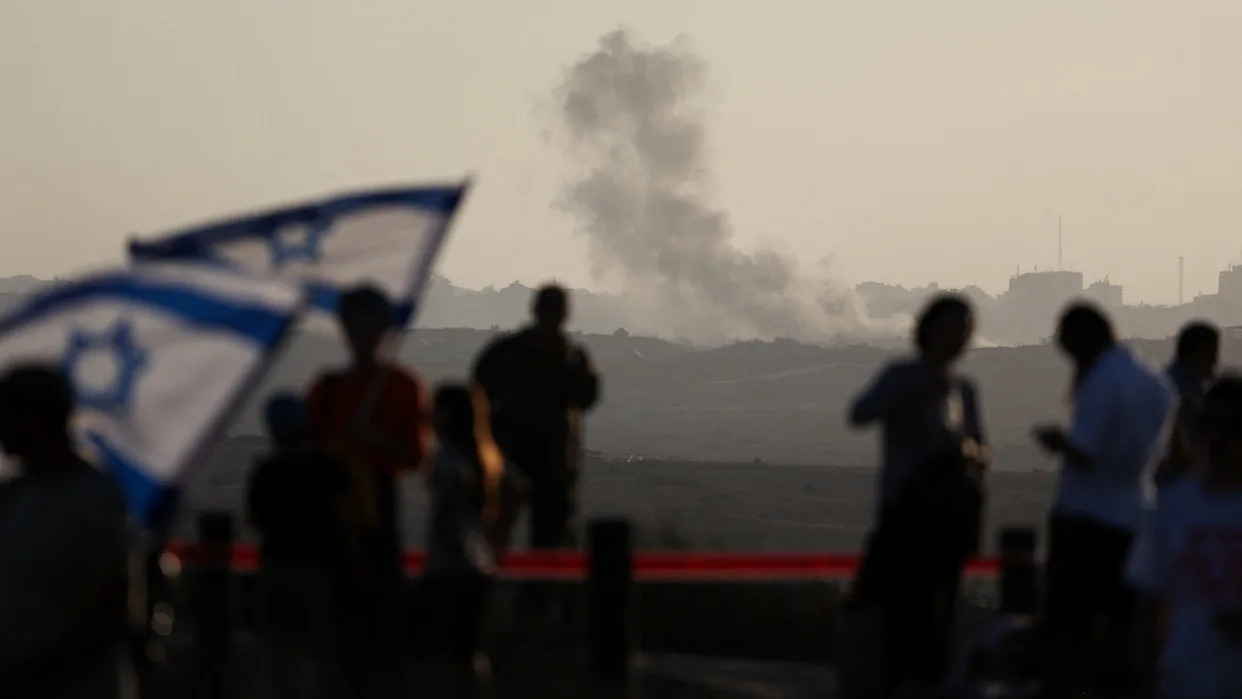
The Atlantic Daily, a newsletter that guides you through the biggest stories of the day, helps you discover new ideas, and recommends the best in culture. Sign up for it here.
After Hamas massacred some 1,200 Israelis on October 7, 2023, the Israeli settler right converged on a plan. In 2005, Israel had uprooted about 8,000 settlers from Gaza, ceding the territory to Palestinian control. Many of the settlers never forgave the state for removing them; now they saw a chance to return. And so while other Israelis mourned, the hard right went to work, methodically building a political movement to retake the Gaza Strip, annex it, and repopulate it with Jewish settlements. As I warned in late 2023, these activists planned on “displacing or expelling Palestinians,” and their dream was “not restricted to the political fringes, and should not be expected to stay there.” Since then, more than a third of the lawmakers in Prime Minister Benjamin Netanyahu’s government have joined the cause.
The Israeli security establishment opposes this land grab. So do most Israelis, surveys have found for years. That dissent spilled into view last week when thousands of settler activists toured the Israeli border region near Gaza. “I hear these things and I’m horrified,” a soldier tasked with protecting the group told a reporter. “It’s revolting, because I know that my friends and younger brother are the ones who will guard those settlements.” Referring to one of the activists, he added: “My greatest fear is that your vision will come true, and that keeps me up whole nights. I don’t want my friends to sacrifice their lives for a goal that sanctifies the death of innocent people.”
But popular opinion may not matter, because Netanyahu is not responsive to popular opinion. The prime minister’s coalition received just 48.4 percent of the vote in Israel’s most recent election, and only came to power thanks to support from far-right anti-Arab parties. Without them, Netanyahu’s government would collapse, and he would have to hold elections that polls show he would lose. In other words, the Israeli leader is beholden precisely to those who aim to annex Gaza and the occupied West Bank. The Biden administration worked to combat this influence, but President Donald Trump has not only relieved that pressure—he has joined the other side, calling for Gazans to be relocated to make way for a “Riviera in the Middle East.” The result: The obstacles to the far right’s blueprint for conquest and ethnic cleansing have been removed, and its agenda has effectively become Netanyahu’s policy.
[Yair Rosenberg: The worst-kept secret of the Israeli-Palestinian conflict]
Unsurprisingly then, the push for settlement and annexation has escalated. Last week, 22 lawmakers in Netanyahu’s coalition signed a letter pressing Israel’s defense minister to allow activists into northern Gaza itself to scout potential settlement locations. “The return of the Jewish people to these places is not just a strategic step,” they wrote, “but a return to Zion in the deepest and most practical sense.” On Sunday, the far-right minister Itamar Ben-Gvir visited the Temple Mount in Jerusalem, the hotly contested holy site, and declared, “We are relaying a message that from today on, we are conquering the entire Gaza Strip, announcing our sovereignty on the entire Gaza Strip, taking down every Hamas member, and encouraging voluntary emigration”—his preferred euphemism for ethnic cleansing.
Right-wing media in Israel have also begun seeding the idea of resettlement in earnest. Last Thursday, Makor Rishon, a newspaper that serves the settler community, ran a story titled “Negotiations on the Verge of Collapse: Israel Prepares for Annexation.” Amit Segal, the best-sourced journalist on the Israeli right, recently promoted a poll with the headline “A Majority of Israelis Support Jewish Settlement in Gaza.” The not-so-resounding results of that survey? Fifty-two percent for, 48 percent against. The poll was commissioned and published by Israel Hayom, the pro-Netanyahu newspaper founded and funded by the late right-wing casino magnate Sheldon Adelson, and it was an outlier on the topic.
Other leaked reports suggest either that Netanyahu plans to fully reoccupy Gaza—a course consistent with potential resettlement—or that he intends to pursue a comprehensive hostage deal that would lead to a negotiated conclusion to the war. These competing narratives reflect an internal information war over Israel’s next steps. Not coincidentally, 19 former heads of Israel’s security services released a video on Sunday calling for Israel to end the war, which they argue has crossed moral and strategic red lines and is now serving another agenda. “There are moments that represent a ‘black flag’ in which one must stand firm and say: This far and no further,” Netanyahu’s former defense minister Moshe Ya’alon declares in the clip, claiming that the government has been suborned by “messianic zealots.”
For now, something intermediate might be in the offing. Segal has reported on a plan to annex the border regions of Gaza as a way to pressure Hamas to release its hostages, because the group “cares more about land than human lives.” Conveniently, this piecemeal annexation could be presented as a military maneuver against Hamas, while also advancing the goals of the settler right—the sort of dual-use policy that Netanyahu has pursued to keep his partners on side since this war began.
Annexation in any form would undoubtedly be met with international opprobrium, threats of sanctions, and further isolation of Israel on the world stage. The cascade of Western countries recognizing a Palestinian state can be understood as an attempt to oppose Israeli designs on the territory. But with Trump still backing Netanyahu, the Israeli leader has little immediate incentive to alter course. Netanyahu is a master of pivoting when politically convenient—including on seemingly core principles—but he tends to choose whatever option keeps him in power, which means that changing his direction requires changing his calculation as to what will accomplish that.
[Franklin Foer: Israel’s last chance]
Over the weekend, Jews around the world observed Tisha B’av, Judaism’s day of mourning that commemorates the destruction of the First and Second Temples in Jerusalem. On Monday, Netanyahu opened his cabinet meeting with a reference to those events: “1,955 years ago, following Tisha B’av, we suffered the greatest defeat in our history,” he said. “At that time, we were divided, splintered, and fighting with one another.” Today, by contrast, “we are in the midst of a great war in which we attained historic achievements because we were not divided, because we stood together and fought together.”
Netanyahu’s boast of Israeli solidarity—made as protests against his war policy and his attempt to fire the attorney general investigating his government roiled the country—rang hollow. But the prime minister’s reference to Tisha B’av was apt, if not for the reasons he thought.
As the Talmud tells it, when the Romans first laid siege to Jerusalem and the Second Temple, the walled city had supplies to withstand the blockade for years to come. The rabbinic sages counseled patience, seeking a diplomatic accommodation that would avert mass bloodshed. Instead, a group of Jewish zealots burned the city’s storehouses in order to force the population to fight rather than wait out or appease their adversaries. Jerusalem was conquered and the Temple destroyed. A radical minority yoked the entire polity to a messianic policy—and the result turned out to be a national catastrophe.





Comments